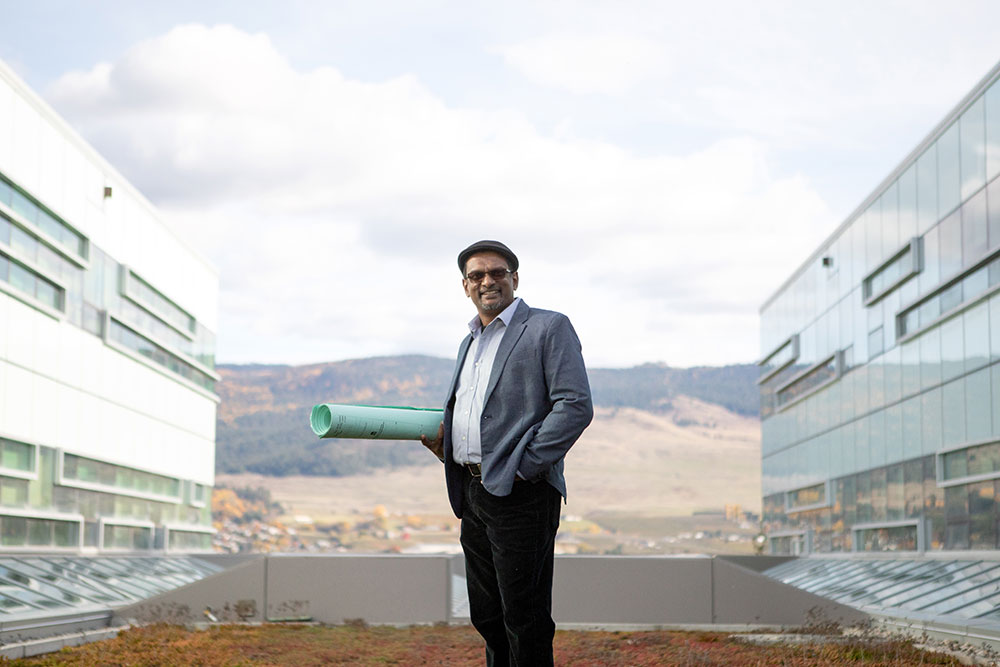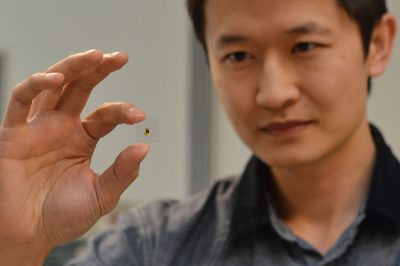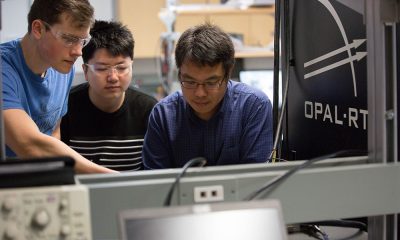
CLIMATE AND POPULATION GROWTH ARE IMPORTANT DRIVERS in how cities and communities evolve around the world — and the challenges arising from these factors will only intensify as urbanization increases and global climates change.
Historical climate data from the Government of Canada and the US-based National Centers for Environmental Information reveals that 17 of the 18 warmest years on record have occurred since 2001, ultimately raising the temperature of the Earth’s bodies of water and impacting climates around the world. And data from the United Nations estimates that by 2030, 60 per cent of the world’s population will call an urban settlement ‘home.’
UBC’s Declaration on the Climate Emergency recognizes that “the climate crisis is posing and will continue to pose extensive and disastrous threats to peoples” lives and livelihoods both locally and globally, contributing to famine, migration and disease worldwide, including impact on individual physical and mental well-being. While some may see the situation as dire, researchers like UBC Okanagan professor Kasun Hewage are examining these challenges holistically to devise new and innovative ways of creating or retrofitting communities.
“We look at our research as a ‘start-to-finish’ process that truly gauges where solutions can be found in important areas,” explains Hewage, an associate director of UBC’s Clean Energy Research Centre and co-lead of UBCO’s Life Cycle Management Lab (LCM). “We’ve learned that if you fail to take this sort of big picture approach, you’ll inevitably impact areas you may not have expected.”
Hewage leads the LCM’s energy portfolio as UBCO’s FortisBC Smart Energy Chair, which aims to help optimize energy use in BC and reduce the province’s greenhouse gas footprint. In addition, Hewage was recognized as UBCO’s 2019 Researcher of the Year in the natural sciences and engineering category for his research evaluation of the implications and cost-benefits of a variety of smart energy solutions related to green buildings.
Through a focus on four key research pillars, Hewage and his team are now developing tools for stakeholders in the areas of building and energy usage.
“From policy to smart buildings, from electric vehicle infrastructure to carbon capturing, our research team is seeking out a path to empower decision-makers with tools to make our communities more sustainable.”
“What inspires us is the opportunity to help governments and industry make sustainable change that will make our world a better place.”
Whether it’s large-scale, complex projects or smaller — yet still impactful — research, the LCM team is striving to make a difference.
“What inspires us is the opportunity to help governments and industry make sustainable change that will make our world a better place,” says Hewage. “For instance, our carbon capturing project explores the potential of taking a technology already used in large industrial operations and seeing if it can be applied to smaller scales.”
He also points to work being done in the School of Engineering to bolster green technologies in a number of areas such as green construction, smart infrastructure, wastewater recovery and green power grids.
Hewage and his colleagues hope their adaptations and innovations will lead to greener and more sustainable communities that will be better able to address the changes experienced today — and in the future.
Creating Soap from Furnace Emissions
What could be more sustainable than extracting the emissions from furnaces and hot water heaters and transforming them into marketable chemical products like soap and detergent? Researchers at the LCM Lab are working with several partners, including FortisBC, to establish an efficient and affordable method of micro-carbon capturing for residential applications.
In this case, carbon dioxide leaving a heating system is captured using potassium hydroxide, which produces heat and potassium carbonate as by-products. The potassium carbonate, also known as pearl ash, can subsequently be used in pharmaceuticals and cleaning products, while the heat can be transferred to domestic hot water systems.
“By exploring this concept of a life cycle thinking approach, we’re investigating energy usage, carbon emissions and sustainable products simultaneously,” explains Rukmal Liyanage, a Master of Applied Science student in mechanical engineering.
Previous research established the feasibility of micro-carbon capturing in larger industrial scenarios, but UBCO’s work is developing the building blocks to eventually bring this technology into apartment buildings and single-family homes.
Analysts suggest the carbon sequestration industry will be worth over a trillion dollars within 10 years, and the Canadian government has set a target of 11.4 per cent growth in clean technology exports by 2025.
A Living Lab on Campus
Most of Hewage’s research involves policy analysis for community planners and builders aspiring to meet British Columbia’s CleanBC initiative, in which every new building constructed in the province must be net-zero energy ready by 2032. Net-zero buildings require all energy consumption to be offset by renewable energy generated on- or off-site.
“Even as BC moves towards this ambitious goal, there’s talk of net-negative buildings that will generate more energy than they use,” explains Hewage. “That’s part of the reason our decision-making tools are so important. Even in the midst of evolving philosophies and approaches, stakeholders have valuable information at hand.”

Engineering professor Kasun Hewage.
Hewage’s team is fortunate to have their own “living lab” on the Okanagan campus; the university is building two of its newest residence buildings to a net-zero standard, and the LCM lab will analyze and evaluate both buildings’ systems to ensure continuous operational improvements. It’s yet another way the university has incorporated sustainability into many aspects of its operations including construction, procurement and service delivery as recognized in UBC’s Declaration on the Climate Emergency.
A similar assessment is currently underway with the province’s charging stations for electric vehicles (EV). The LCM team has developed a demand prediction model for EV recharging stations, which could one day support the development of province- and nation-wide EV recharging infrastructure plans.
Innovation in Green Construction
UBCO, Okanagan College and Wilden Living Lab are collaborating to develop an experiential learning environment for students, researchers and industrial partners where innovative green construction can thrive.
The Green Construction Research and Training Centre generates and expands knowledge in the areas of green (environment-friendly) construction — including materials, structural components and systems, and construction management. The objective is to create civil infrastructure that is safe, durable, energy-efficient and affordable through innovative technologies.
A number of industry collaborations are already underway, with anticipated spin-off companies creating a community that supports self-sustainability and local economic development.
Shahria Alam, a professor in civil engineering, is co-director of the centre. His research focuses on smart materials and their structural applications in infrastructure, including seismic rehabilitation of structures and performance-based design.
As a research leader in the field of green construction, Alam has published more than 275 peer-reviewed articles. Throughout his career, his goal has remained the same: to grow the green construction sector in Canada and around the world.
“This joint initiative with Okanagan College will equip our students and researchers with the tools necessary to continue to innovate in the areas of green construction with a focus on sustainability,” he adds. “As a result, I see an exciting future for the green construction sector in the Okanagan.”
Smart Windows
Imagine a home filled with windows that could selectively filter light and heat waves, depending on the season or time of day. Researchers at UBCO are exploring how to make this a reality as they search for an answer to efficiently heat and cool buildings.

Professor Kenneth Chau with a piece of smart glass.
Associate Professor Kenneth Chau and his colleague Loïc Markley are investigating the potential of integrating electronic capabilities into windows. “Engineers are constantly trying to expand the scope of materials they can use for display technologies, and having thin, inexpensive, see-through components that conduct electricity will be huge,” explains Chau.
One such component could be windows themselves, which could double as a giant thermostat within a home or even as a big screen TV. Chau and Markley have questioned what would happen if they reversed the practice of applying glass over metal — a typical method used to create energy efficient window coatings.
“It’s been known for quite a while that you could put glass on metal to make metal more transparent, but people have never put metal on top of glass to make glass more transparent,” Markley explains. “It’s counter-intuitive to think that metal could be used to enhance light transmission, but we saw that this was actually possible, and our experiments are the first to prove it.”
The researchers continue to investigate the possibilities of applying their findings to real-world applications.
Making Waste into Energy
Partnering with local municipalities and utilities, UBCO professor Cigdem Eskicioglu explores waste-to-energy options, waste minimization and odour-reduction solutions.
“My interest in environmental issues came from my own first-hand experiences with traffic jams and lack of clean water and air, which most of us here in Canada take for granted,” says Eskicioglu, who witnessed vast environmental concerns in her home country of Turkey.
Eskicioglu — an Industrial Research Chair in Advanced Resource Recovery from Wastewater — now leads the UBC Bioreactor Technology Group, which collaborates with government agencies, municipalities, industries and researchers within UBC and other institutions to reduce waste and increase resource recovery.
Her research focuses on biological waste treatment processes, or anaerobic digestion, that can utilize microorganisms to turn organic waste into renewable energy (methane) and organic fertilizer. Eskicioglu works with emerging micro-pollutants, such as hormones, pharmaceuticals and pesticides.
According to Eskicioglu, UBCO and its partners are striving to meet renewable-energy requirements outlined in British Columbia’s CleanBC energy plan. “In just over a decade, we’ve been able to develop strong partnerships with Metro Vancouver and the City of Kelowna to explore their waste-to-energy options, waste minimization and odor reduction needs.”
With similar challenges faced internationally, the Bioreactor Technology Group has been attracting many visiting scholars from around the world to complement its many global institutional collaborators, such as the Laboratory of Environmental Biotechnology at the National Institute for Agricultural Research in France and the Group of Environmental Engineering and Microbiology at the Polytechnic University of Catalonia in Spain.
Securing the Future of Distributed Energy
As power utilities around the world continue to move towards more renewable solutions, the distribution of power is evolving as well.
Conventional power sources like coal, gas, nuclear and even hydroelectric power stations transfer electricity to users over long distances, but renewable sources like wind and solar are forcing utilities to reimagine how power can — and should — be distributed.
“Changing systems that have been around for decades is no easy feat,” explains Assistant Professor Liwei Wang, who’s on the cutting-edge of this transition.

Professor Liwei Wang in his lab with students.
Working with North Vancouver-based Enbala Power Networks, Wang and his team are developing software that ensures distributed energy resources are managed accurately and effectively.
According to Wang, many challenges exist when building distributed energy resource management systems. “Reliability, security and speed of communication channels are all vital components to the system, but so are cost and appropriate testing facilities.”
Through a Canada Foundation for Innovation grant, Wang, Associate Professor Wilson Eberle and their graduate students have built a state-of-the-art facility for simulating distributed energy resource management systems. The equipment allows for testing of physical and virtual assets within a controlled system, simulating real-world scenarios without the dire consequences of testing within an active system.
The next step, says Wang, is to develop solutions that enable control of multiple systems from one location, which will allow real-time adjustments to optimize systems across entire power grids.
“Our real-time simulator and internet-of-things cloud solutions create an ideal testing facility,” says Wang. “It provides us with a great platform to further this research.”